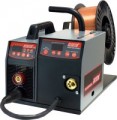Max. welding current (duty cycle 100%)
The highest welding current at which the machine is able to operate with a duty cycle of 100%.
See below for more information on the frequency of inclusion (PV). Here we recall that “100% duty cycle” means continuous operation, without shutdowns for cooling. Thus, the maximum welding current at 100% duty cycle is the highest current at which the machine can be used without interruption. Usually, this current is much lower than the maximum.
Wire feed speed
Wire feed speed provided by the semi-automatic model (see "Type"). The higher the speed (with the same thickness) — the faster you can lead the electrode over the seam and the less time the process takes. On the other hand, too fast feed makes it difficult to work with seams of small length. Detailed information on the optimal wire feed speed can be found in special sources.
Coil location
The location of the wire feed spool.
The wire is used in semi-automatic welding (see "Type of welding"); the coil on which it is wound can be located both outside the device and inside. There is no fundamental difference in the design of the feed mechanism, in efficiency and in other operating parameters between the "external" and "internal" models, they differ mainly in the features of storage and transportation. For example, the built-in coil increases the size and weight of the entire device, but it does not need to be carried separately.
Protection class (IP)
The protection class to which the housing of the welding machine corresponds.
This parameter is traditionally denoted by the IP standard with two digits. It characterizes how well the case protects the hardware from foreign objects and dust (first digit), as well as from moisture (second digit). It is worth noting that in welding machines the degree of such protection is usually small — this is due to the fact that the case must be made ventilated. Here are the levels of protection against solid objects / dust that are relevant for modern models:
1 — protection against objects larger than 50 mm (comparable to the size of a human fist or elbow);
2 — from objects larger than 12.5 mm (we can talk about protection from fingers);
3 — from objects larger than 2.5 mm (the probability of accidental hit by most standard tools is excluded);
As for protection against moisture, it can be generally zero — that is, such a device can only be used in dry conditions. However, there are more advanced options:
1 — protection against drops of water falling vertically, with a strictly horizontal position of the device (the minimum degree of protection, in fact — from accidental ingress of a small amount of moisture);
2 — from vertical drops of water when the device deviates from the horizontal up to 15 ° (slightly higher than the minimum);
3 — from splashes falling at an angle of up to 60 ° to the vertical (we can talk about protect...ion from rain);
4 — from splashes falling from any direction (possibility of use in rain with strong winds);
Sometimes, instead of one of the numbers, the letter X is put — for example, IP2X. This means that the protection class for the corresponding type of exposure is not defined. In such a case, it is best to assume that there is no protection at all — this will provide maximum security and avoid unpleasant surprises.

